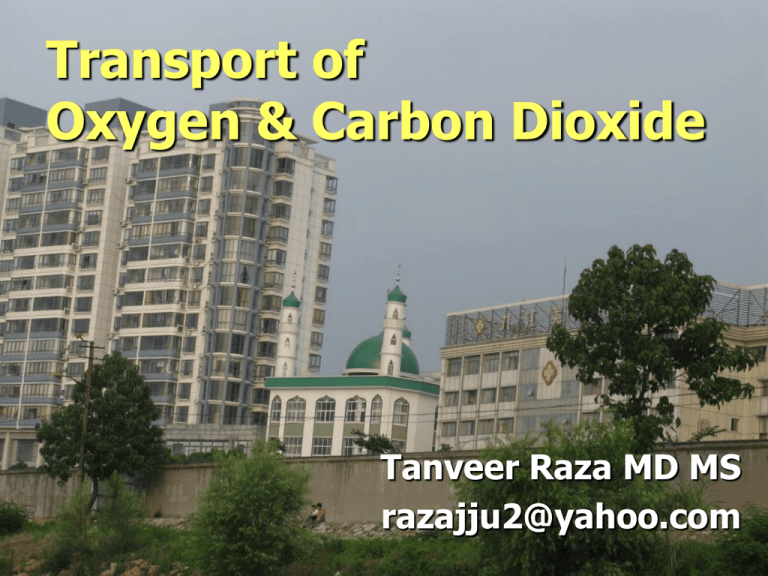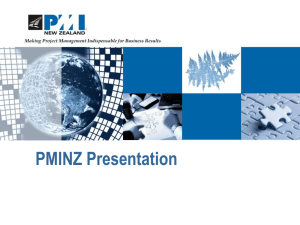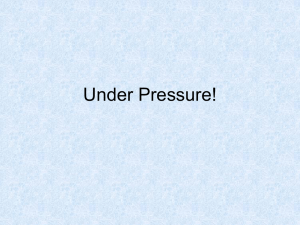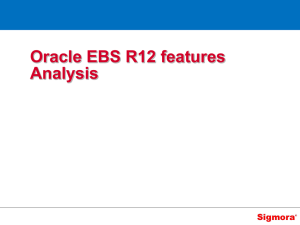Transport of Oxygen and Carbon Dioxide
advertisement

Transport of Oxygen & Carbon Dioxide Tanveer Raza MD MS razajju2@yahoo.com Hemoglobin (Hb) increases total blood oxygen capacity (30-100 times more) CO2 transport increases 15- to 20- fold in combination with chemical substances in blood Diffusion Alveoli Blood vessels Tissue Diffusion of Oxygen from Alveoli to Pulmonary Capillary Blood In alveolus PO2 104 mm Hg PO2 of blood at its arterial end 40 mm Hg Initial pressure difference causing O2 to diffuse into pulmonary capillary is (104-40) 64 mm Hg Diffusion of Oxygen from Alveoli to Pulmonary Capillary Blood PO2 rises almost to that of alveolar air by the time blood has moved a third of the distance through the capillary, (PO2= 104 mm Hg) Diffusion of Oxygen Shunt flow Blood entering Left Atrium • About 98% comes from lungs [PO2 = 104 mm Hg] • 2% comes from bronchial circulation [PO2 = 40 mm Hg] This blood is not exposed to lung air. It is called "shunt flow" meaning blood is shunted past gas exchange areas. PO2 is that of normal systemic venous blood Shunt flow Blood combines with the blood from alveolar capillaries (the venous admixture of blood ) causing PO2 of blood entering the left heart and pumped into the aorta to fall to about 95 mm Hg Diffusion of Oxygen from Peripheral Capillaries to the Tissue Fluid and Tissue Cells Capillaries entering peripheral tissues In interstitial fluid PO2 = 95 mmHg PO2 = 40 mmHg Rapid diffusion of O2 from capillary blood into the tissues In capillaries leaving peripheral tissues PO2 = 40 mmHg Diffusion of Oxygen from Peripheral Capillaries to the Tissue Fluid and Tissue Cells Normal intracellular, PO2=5 – 40 mmHg, average 23 mm Hg O2 pressure required for chemical processes in cell is 1-3 mmHg Intracellular PO2 of 23 mmHg is more than adequate and provides a large safety factor Effect of Rate of Blood Flow on Interstitial Fluid PO2 Effect of Rate of Tissue Metabolism on Interstitial Fluid PO2 Rate of Blood Flow on Interstitial Fluid PO2 – Increased blood flow will increase tissue PO2 Rate of Tissue Metabolism on Interstitial Fluid PO2 – If cells use more O2 the interstitial fluid PO2 will decrease Diffusion of CO2 Almost all O2 converts to CO2 in tissues CO2 diffuses 20 times rapidly than O2 CO2 diffusion is exactly opposite to O2 Diffusion of CO2 from Tissue Fluid and Tissue Cells to Peripheral Capillaries Intracellular Interstitial Pressure difference PCO2 = 46 mmHg PCO2= 45mmHg = 1mmHg Diffusion of CO2 from Tissue Fluid and Tissue Cells tp Peripheral Capillaries Interstitial PCO2=45mmHg Arterial end capillary PCO2=40mmHg Venous end capillary PCO2=45mmHg Diffusion of CO2 from Pulmonary Capillary Blood to Alveoli Arterial end Alveolar air Pressure difference PCO2=45mmHg PCO2=40mmHg =5mmHg Diffusion of CO2 from Pulmonary Capillary Blood to Alveoli PCO2 equals that of alveolar air [PCO2 =40mmHg] by the time the blood has moved a third of the distance Effect of Rate of Blood Flow on Interstitial Fluid PCO2 Effect of Rate of Tissue Metabolism on Interstitial Fluid PCO2 Role of Hb in O2 Transport Under normal conditions, O2 is transported to the tissues almost entirely in chemical combination with Hb Hb Dissolved in water of plasma and blood cells 97% 3% Combination of O2 with Hb Loosely and reversibly with heme portion of Hb When PO2 is high in pulmonary capillaries O2 binds with Hb When PO2 is low in tissue capillaries O2 is released from Hb Oxygen-Hemoglobin Dissociation Curve Oxygen-Hemoglobin Dissociation Curve Demonstrates progressive increase in the percentage of Hb bound with O2 as blood PO2 increases, which is called the per cent saturation of hemoglobin – In systemic arteries the saturation averages 97% [PO2=95 mm Hg] – In normal venous blood saturation of averages 75% [PO2=40 mm Hg] Oxygen-Hemoglobin Dissociation Curve Oxygen-Hemoglobin Dissociation Curve Maximum O2 that can combine with Hb in blood – Hb in normal person 15 gm Hb/100ml blood – 1 gm of Hb binds with maximum 1.34 ml O2 (1.39 ml when Hb is chemically pure, but impurities such as methemoglobin reduce this) – 100% Hb combines with 15 x 1.34 ml O2 approx. 20 ml of O2 – Usually expressed as 20 volumes per cent Oxygen-Hemoglobin Dissociation Curve • Can also be expressed as volume per cent of O2, instead of per cent saturation of Hb Thank You







